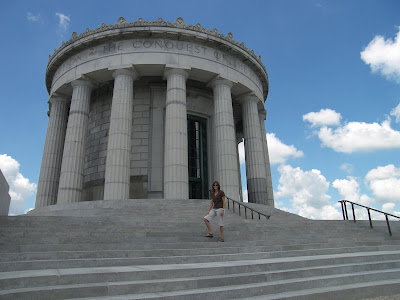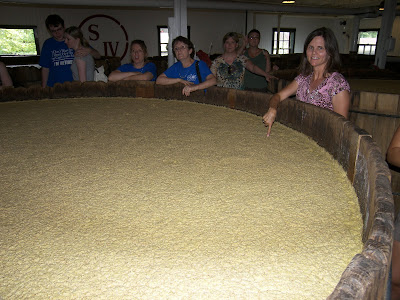June 29, 2010
 June 29, 2010
June 29, 2010From Lincoln State Park we drove a couple hours to Vincennes, IN to visit George Rogers Clark National Historic Park. Our first view is of the gigantic memorial to him. It is the size and shape of the Jefferson Memorial in DC. Apparently George is more famous than I realized.
 George is the older brother of William who explored the Louisiana Territory with Meriwether Lewis. In the Visitor Center we learn that he along with Daniel Boone were the primary trailblazers leading pioneers from Virginia to new lands in Kentucky and Tennessee. When the Revolutionary War started the British paid the Indians to attack American colonists in Kentucky. George Rogers Clark led a militia to attack British outposts at Kaskaskia, Cahokia and here in Vincennes. To secure Vincennes he led his troops on a winter forced march across Illinois. As a result when the Treaty of Paris was negotiated the US gained the Northwest Territory. If it wasn’t for this victory, I would be writing this journal in Canadian.
George is the older brother of William who explored the Louisiana Territory with Meriwether Lewis. In the Visitor Center we learn that he along with Daniel Boone were the primary trailblazers leading pioneers from Virginia to new lands in Kentucky and Tennessee. When the Revolutionary War started the British paid the Indians to attack American colonists in Kentucky. George Rogers Clark led a militia to attack British outposts at Kaskaskia, Cahokia and here in Vincennes. To secure Vincennes he led his troops on a winter forced march across Illinois. As a result when the Treaty of Paris was negotiated the US gained the Northwest Territory. If it wasn’t for this victory, I would be writing this journal in Canadian.From the Park, Aimee and I walked thru the historic area to Grouseland, home of William Henry Harrison, when he served as Governor of the Indiana Territory in 1800. We were given a tour of the period home by a very knowledgeable docent and then we perused a series of exhibits on Harrison’s life. Harrison gained military fame for his later victories in the Shawnee Indian War and against the British in the War of 1812. He was elected president in 1840. Unfortunately he gave the longest ever inaugural address on a cold wet winter day, got pneumonia, and died after only thirty days in office. Now he is only known for having the shortest presidency.
From Vincennes, we drove to Effingham, IL to have dinner with my oldest sister. Afterwards we drive the last couple hours to Godfrey to spend Independence Day with my parents.

























